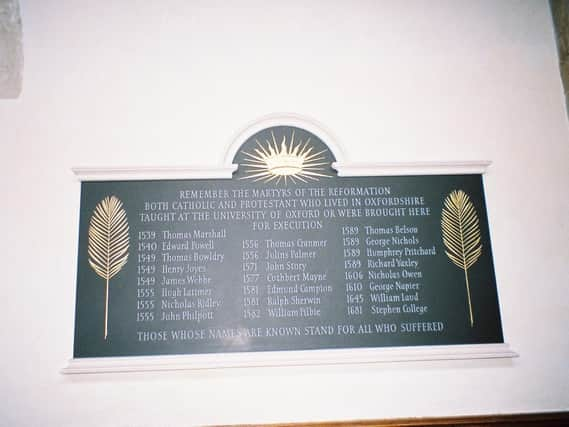How former a former Advertiser reporter's namesake, and distant relative, was burned at the stake


People living in this part of north-east Warwickshire back in the middle of the 16th century would have been well advised to think carefully when discussing religion.
For you never knew who you were talking to. That apparently friendly stranger in the tavern or ale house might well betray you to the authorities…
Advertisement
Hide AdAdvertisement
Hide AdThe recent Reformation had brought about enormous changes to everyone’s lives, the new Protestantism was on the rise, and no doubt scholars up and down the land back then were discussing theological issues well into the small hours.
But there was just one huge fly in the vestal ointment… and that was the accession of Mary Tudor to the throne. Mary was a committed Catholic and determined to crush the new religion.
The seeds of Protestantism had been sown just over the county border in Lutterworth, Leicestershire, by priest John Wycliffe during the 14th century.
After his death, Wycliffe’s bones were dug up, burned and his ashes thrown into the River Swift.
Advertisement
Hide AdAdvertisement
Hide AdWhen Mary succeeded to the throne on the death of her Protestant brother, Edward VI, she started what would later be termed the Marian persecutions.
Heretics were given the opportunity to recant – ‘turn or burn’ - but many persisted in denying the Pope’s supremacy and ‘the real presence.’
They also refused to accept the ‘transubstantiation,’ the belief that the wine and bread literally becomes the blood and flesh of Christ.
The persecutions soon started in earnest, with the first public burnings of ‘heretics’. But these appalling bonfires were destined to become a conflagration that soon consumed all of England.
Advertisement
Hide AdAdvertisement
Hide AdAnd north Warwickshire in particular. In 1557, just along the Watling Street in Mancetter, near Nuneaton, a Joyce Lewis was burned at the stake for refusing to renounce her faith.
Together with Robert Glover, also of Mancetter, they died an agonising death by fire.
And it was at this time that a brave local churchman entered the fray. The rector of Southam, Augustine Bernher, was servant to another martyr, Hugh Latimer, and he was determined to do what he could to help the victims of the wave of terror that was sweeping the country.
Bernher accompanied the wretched Glover to the stake and tried to comfort the poor man as he anticipated an appalling death that we can only begin to imagine.
Advertisement
Hide AdAdvertisement
Hide AdJoyce Lewis was also comforted by Bernher, and he inspired her so much that she showed unflagging courage at the stake. He was at her side until the last moments, breathing the final prayer and benediction.
Incredibly, Joyce Lewis was resolute to the end. A witness who saw her chained to the stake said that she manifested a cheerful serenity and “countenance so unchanged as to astonish all who beheld her.”
It was said that she died triumphantly, “her hands lifted to Heaven.” But Bernher’s work was far from finished. A Bishop Jewel, described as the ‘father of the Reformation,’ was fleeing persecution when he encountered Bernher on the road near Southam.
Initial feelings of apprehension and terror turned to joy when the mysterious stranger revealed himself as a friend - for Bernher not only gave Jewel his horse, but also enough money to sustain him while he went into hiding in London.
Advertisement
Hide AdAdvertisement
Hide AdA writer in Arthur Mee’s Warwickshire said of Bernher: “How he himself escaped is a mystery, for he thought only of others and counted his own life as nothing.”
A total of 283 people were burned alive during Bloody Mary’s reign. Her successor Elizabeth sought to build bridges between the rival faiths, although these were mainly doomed to failure.
For Warwickshire – like the rest of the country – remained a land divided, rather than united, by religion. And that would be very much the Virgin Queen’s cross to bear throughout a long and eventful reign that had at least brought and end to what would be henceforth be known as England’s Terror.
Mary Tudor reigned from 1553 to 1558. She married King Philip of Spain, a move that was very unpopular throughout the country. She was succeeded by her half sister, Elizabeth, who abolished Papal Supremacy in 1559, a year after her ascent to the throne.
Advertisement
Hide AdAdvertisement
Hide AdJohn Foxe’s Book of Martyrs listed all the people who died for their faith. He believed the population should know of their sufferings. And all English ships that fought the Spanish Armada carried a copy of John Foxe’s book.
The crews believed they were fighting to save their country from a repetition of the horrors of Mary’s reign.
Archdeacon John Philpott, the son of a knight of Compton, Hampshire, refused to recant his faith and was burned alive at Smithfield, on December 18, 1555.
I am distantly related to him through family ancestors originating in Kent and Hampshire.
John Phillpott’s book Beef Cubes and Burdock: Memories of a 1950s Country Childhood devotes an entire chapter to the courageous story of Lutterworth’s ‘troublesome priest’ John Wycliffe.